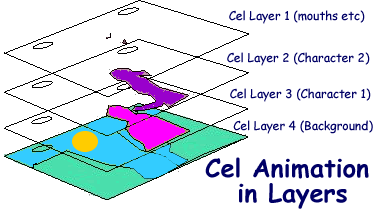The traditional form of animation used by most when producing an animated sequence by drawing the characters ( traditionally by hand on to plastic sheets) now it is done on computers and isn't hand drawn however some of the most popular shows in american television history are made by using cel animation.
The illusion of animation is created by moving different points on something to make it move, this can get incredibly hard and complex which is why the job of animator is highly sought after although the average salary is not that good. A cel based animation production is most used because of the wide diversity of things you can do, you can have the freedom to make anything whether violent or romantic these themes would definitely be harder to achieve on other formats of animation, here is an example of Family Guy An American Animated series that used crude humour and violence for humorous effect.

Process Of Cel Animation
First, a storyboard is created showing a quick sketch of the general idea and direction of the cartoon. Next, the dialogue is recorded before the actual animators create the final inked cartoons on pieces of clear celluloid acetate, or cels. After inking, animators paint in the colour on the opposite side of the cel and finally combine all the cels to be photographed, using a special film motion picture camera. Cel animation allows animators to repeat certain frames, eliminating the need to draw each individual frame over and over in a sequence of animation. Backgrounds and fixed objects may be included in every background cel while other cels are removed and replaced over and over to simulate movement by animated characters. For example, if there are two characters in a scene and only one character is moving in this scene, an animator would draw character A on a clear piece of film called a cel. Then, using another second cel, the animator will draw character B. As character A is jumping up and down in a sequence of moves, a new cel is created for each movement. These cels are then combined and shot on a special film camera in a logical sequence that makes character A look like he's jumping up and down, while character B remains unmoving. The animator can just leave the first cel attached to the base plate which contains the unmoving character B while placing and removing the cel containing character A's movement sequence. When each subsequent cel containing character A's movements is placed on the plate, a special camera takes a quick shot of both characters that appear together. These quick shots are combined later to simulate movement, or animation.
The illusion of animation is created by moving different points on something to make it move, this can get incredibly hard and complex which is why the job of animator is highly sought after although the average salary is not that good. A cel based animation production is most used because of the wide diversity of things you can do, you can have the freedom to make anything whether violent or romantic these themes would definitely be harder to achieve on other formats of animation, here is an example of Family Guy An American Animated series that used crude humour and violence for humorous effect.

Process Of Cel Animation
First, a storyboard is created showing a quick sketch of the general idea and direction of the cartoon. Next, the dialogue is recorded before the actual animators create the final inked cartoons on pieces of clear celluloid acetate, or cels. After inking, animators paint in the colour on the opposite side of the cel and finally combine all the cels to be photographed, using a special film motion picture camera. Cel animation allows animators to repeat certain frames, eliminating the need to draw each individual frame over and over in a sequence of animation. Backgrounds and fixed objects may be included in every background cel while other cels are removed and replaced over and over to simulate movement by animated characters. For example, if there are two characters in a scene and only one character is moving in this scene, an animator would draw character A on a clear piece of film called a cel. Then, using another second cel, the animator will draw character B. As character A is jumping up and down in a sequence of moves, a new cel is created for each movement. These cels are then combined and shot on a special film camera in a logical sequence that makes character A look like he's jumping up and down, while character B remains unmoving. The animator can just leave the first cel attached to the base plate which contains the unmoving character B while placing and removing the cel containing character A's movement sequence. When each subsequent cel containing character A's movements is placed on the plate, a special camera takes a quick shot of both characters that appear together. These quick shots are combined later to simulate movement, or animation.
Modern animators have said to have taken inspiration from the likes of Walt Disney or the Hanna-Barbera Company that consisted of the two co founders: Joseph Barbera and William Hanna.
and also the Polish born American Max Fleischer who created characters like Betty Boop and Popeye.
No comments:
Post a Comment